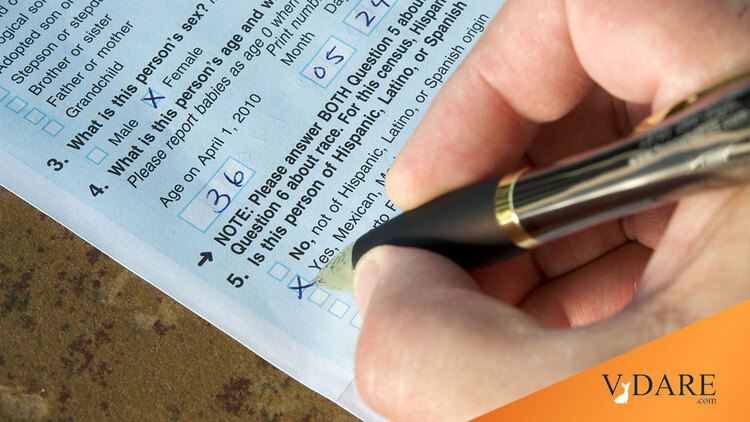


09/17/2008
The Census Bureau may look like the gold standard of government bean-counters, immersed as it is in the logic of numbers. But the agency also has a propaganda wing tucked among the spreadsheets, pimping the idea that America’s multiculturalization and its massive population growth promises a fine future for the country
It’s bad enough when institutions from La Raza to the Department of Health and Human Services push the agenda of a bilingual and Hispanic America. Concerned citizens would prefer that the Census let the numbers stand on their own.
But no such luck.
In some instances, the statistics are presented in ways that are outright misleading and slant toward values that many citizens reject, for example social engineering that promotes diversity and radical population growth.
The home of diversity promotion on the Census.gov website is located on the Newsroom page.
But the multicultural sweet spot is found in the Facts for Features collection. Here many items are timed for calendar events of various seriousness, e.g. Irish-American Heritage Month in March, Back To School in the fall — and even Single Americans Week (Sept 21-27)!
What’s objectionable in these statistics-filled lists is the relentlessly positive view of continuing growth and never-ending diversity. The Census must assume that its audience is mostly MainStream Media hacks, looking to pad their open-borders fluff with a few facts.
The Census' bias is unmistakable.
For example, the Irish education numbers are given alongside useful comparisons that indicate the Irish place in American society. But there is no such baseline provided for the Hispanic Heritage Month edition. Thus:
versus
and
The Census is too politically correct to show what is common knowledge: that Hispanic culture, and particularly Mexican, is education-averse. Half of Hispanic high school students drop out, compared to a graduation rate for American whites of some 81%.
Worse, even fourth-generation Mexican-Americans have not assimilated to US standards of learning. Only 9.6 percent achieve a post-high-school degree, compared with 45.1 percent of Americans as a whole.
By leaving out important points of comparison, the reader might incorrectly think that Hispanics are performing satisfactorily.
But the facts don’t support that. In fact, 27 percent of adult Americans have attained a bachelor’s degree — twice the Hispanic rate — according to the Census elsewhere.
Another Census technique is to present alarming information about rapid cultural change without a timeline. The reader then has no idea how monumental a transformation is being engineered.
Thus the Hispanic Heritage section on the Spanish language consists of several statistics about who speaks what language and where it is spoken. But it contains no reference to explain the rate of that change or the cost of teaching English to Hispanic children, assuming that goal is still accepted as desirable.
For example:
And crucially:
The Census takes the same happy-face attitude toward extreme population growth, even though the harm to our ecosystem has been obvious for some time.
Since when was "crowded" a desirable attribute? But when the official Census clock clicked over to 300 million residents in the United States on October 17, 2006, agency employees gathered and applauded the event.
Some numerical milestones are better than others. We genuinely welcome our 21st birthday. But as the years pass over decades, we are not so overjoyed.
Similarly, the glow of population growth has faded. Even some MSM pundits noticed that the 300 million milestone was not entirely positive news.
The Census often presents jaw-drop statistics of immoderate population growth in separate bits, while some raw numbers and changes in significant percentages that would make the information more meaningful are noted separately.
Here’s more from the Hispanic Heritage selection, where explosive population growth is obliquely hinted:
Would Census readers find it interesting that the number of Hispanics projected to reside in America in 2050 — 133 million — equals the entire population of the United States in 1941? There’s no hint of what a radical transformation is underway. Concerned citizens are only offered breezy, disconnected factoids from their government statistician.
In addition, there is nothing in the Hispanic Heritage fact sheet that is remotely pessimistic. If it is unpleasant, it’s omitted. Glaring examples include the high rates of incarceration, school failure, criminal gang activity and the many millions of lawbreaking illegal aliens who came from south of the border.
The Census does make somewhat of an exception to its upbeat tone about Hispanics when it reports poverty.
But by comparison — which the Census Bureau does not provide — only 12.5 percent of Americans as a whole lived in poverty in 2007, and only 8.2 percent of non-Hispanic Whites. Don’t those figures make the Hispanic numbers more meaningful?
Imagine if the Census Bureau could repackage its presentation to reflect America’s real needs and spent less time issuing Chamber of Commerce-like press releases.
The Census has a wealth of useful facts, like the poverty statistics I just cited. But it prefers to crank out saccharine cheerfulness instead of neutral information.
Is it too much to ask that the Census present its knowledge in a meaningful context?
Americans have a right to expect the Census Bureau to be more than a diversity propaganda operation.
(Email the Census Bureau.)
Brenda Walker lives in Northern California and publishes two websites, LimitsToGrowth.org and ImmigrationsHumanCost.org. She fears that the Census Bureau is turning into a den of xenophiliacs, (persons with an uncontrollable enthusiasm for foreigners).